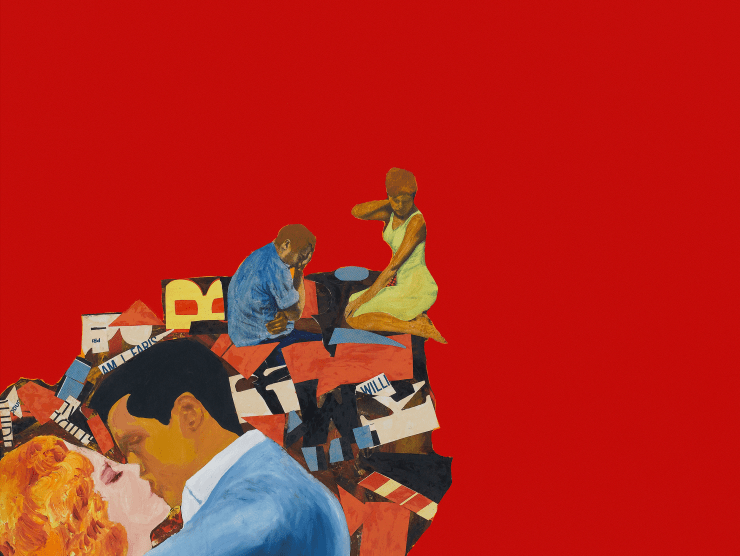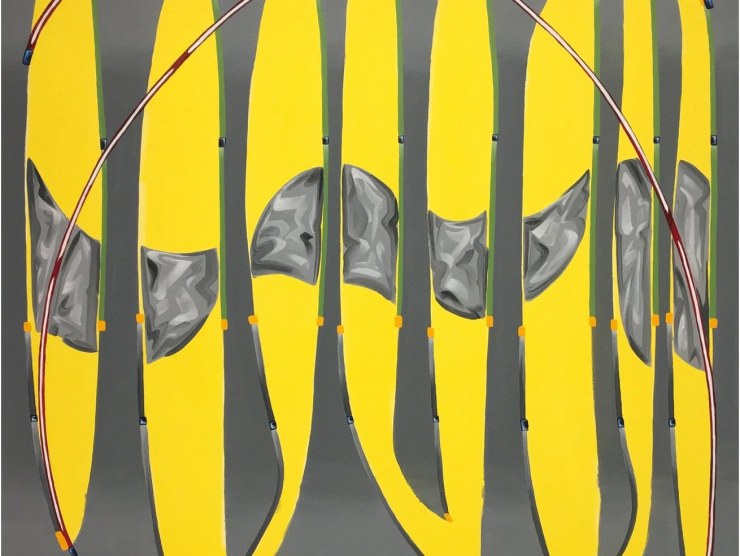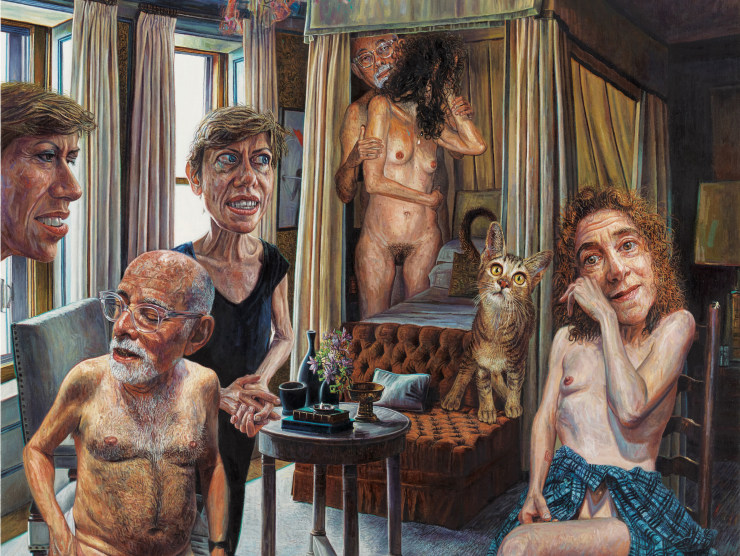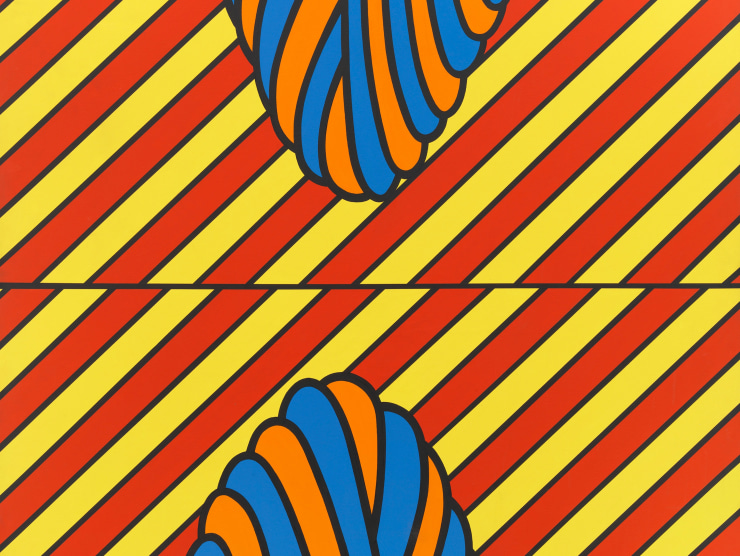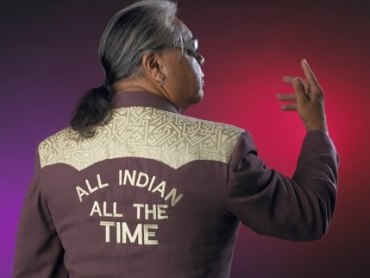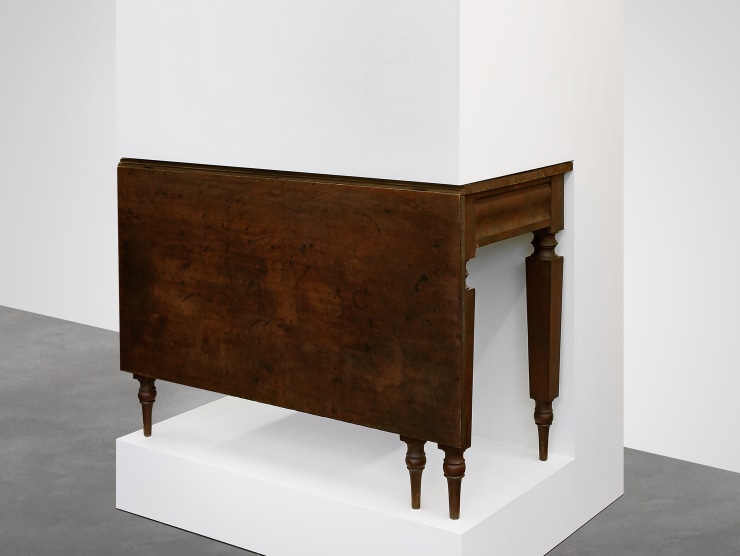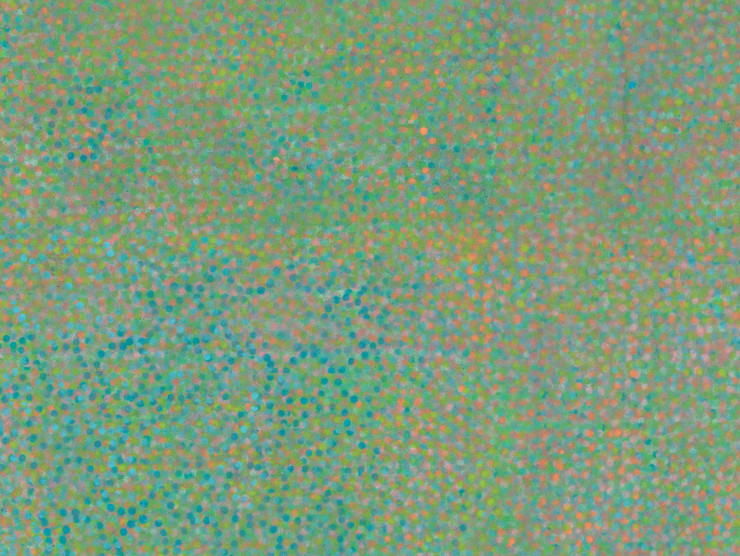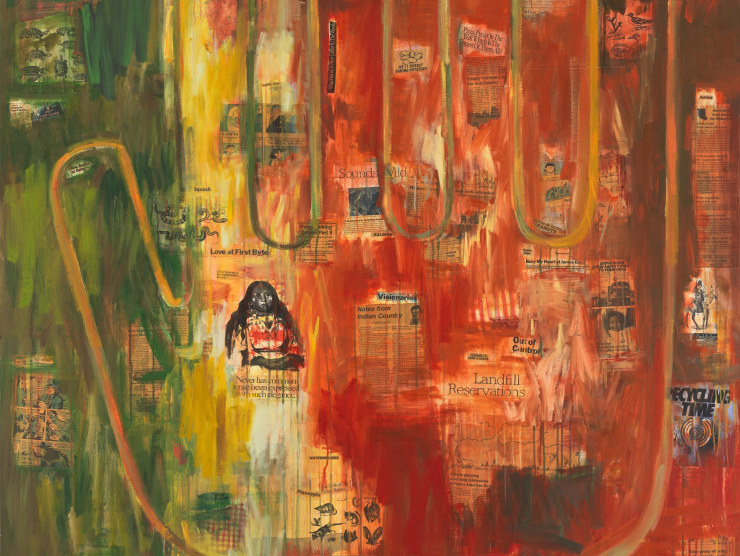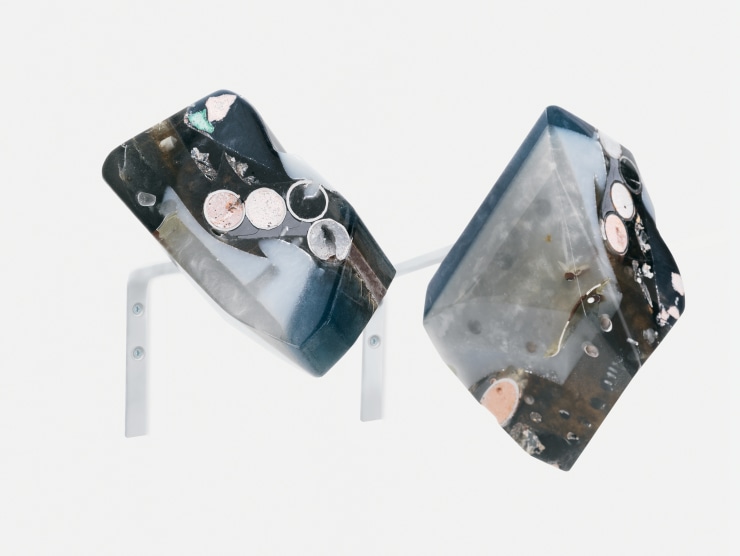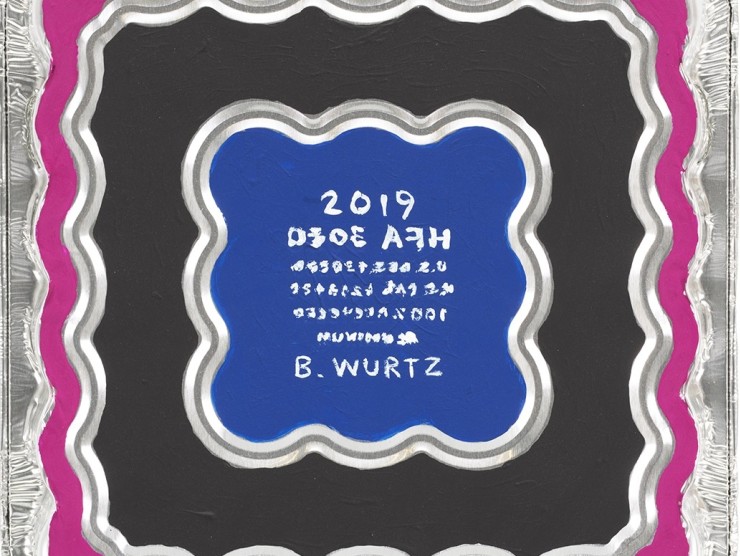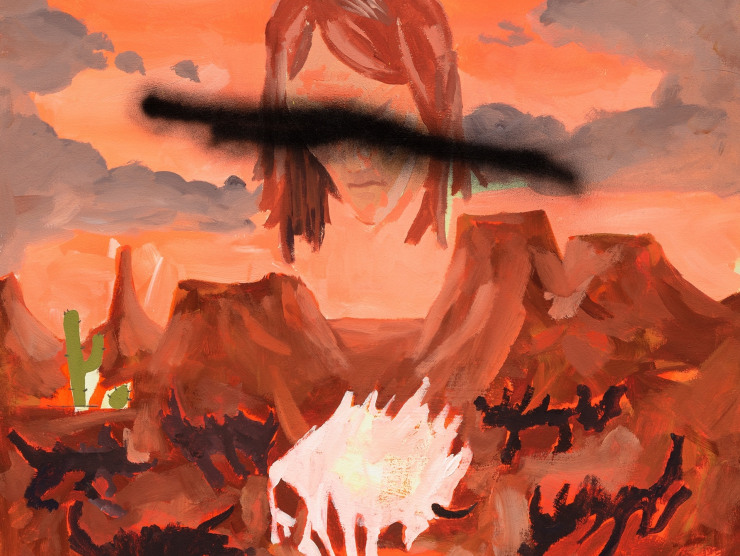
For the 2021 edition of Art Basel: Miami Beach, Garth Greenan Gallery is pleased to present an exhibition of signature works by gallery artists: Esteban Cabeza de Baca, Melissa Cody, Rosalyn Drexler, Mark Greenwold, Nicholas Krushenick, James Luna, Roy McMakin, Howardena Pindell, Jaune Quick-to-See Smith, Richard Van Buren, B. Wurtz, and Lawrence Paul Yuxweluptun. Throughout their careers, these artists have formed a complex web of direct and indirect mutual influence, creating spaces for each other by breaking new ground in their abstract, concept, or process-oriented works. Each artist in the presentation is distinguished by their iconic visual style, and by deep political commitments that often formed ambivalent relationships with their work.
The late James Luna was a master at subverting and complicating cultural expectations surrounding Native American identity. In the mock album cover All Indian All the Time, (2006), the artist disarms the viewer with his characteristic humor in the song title, “Why can’t I be rich instead of so damn good looking?” The album is self-titled, “James Luna with the high cheekbones”—a descriptor that maps neatly onto a Native American stereotype, but not to the artist himself. A sense of gravity mixes uneasily with the artist’s jokes. “Everything is sick and wrong,” declares his other title track.
Like Luna’s works, Smith’s poetic, curious, and profound interpretations of America’s particular forms of bigotry toward Native peoples often utilize humor in striking and unsettling ways. In Trade Canoe: Don Quixote in Sumeria (2005), the artist depicts the mixed bag that Native Americans ostensibly received in consolation for land, life, and culture: Christianity and the devil, Disney, Byzantine icons, Batman, invasive pests, and Picasso.
Esteban Cabeza de Baca takes this mosaic inheritance as a starting point, employing a broad range of painterly techniques, entwining layers of graffiti, landscape, and ancient symbols. His work often draws on his complex ancestry as a person of Native American and Mexican descent with a direct link to the Spanish conquistador-turned-spiritual-healer Álvar Núñez Cabeza de Vaca. His painting Ojo Caliente a Paternal (2020) was done en plein air, recasting the practice of landscape painting—once the preferred surveying tool of colonizers—within his own practice. The artist’s hybrid techniques and influences form a complex braid, interrogating the dialectical relationships between colonialism and its critique.
Also included in the presentation is Howardena Pindell’s recent Untitled (2021), her first spray dot painting in over 30 years. The artist’s spray dot paintings of the 1970s were some of the earliest progenitors of her most iconic works. In Untitled, the artist punches hundreds of holes in heavy paper, creating stencils through which to blow paint onto the canvas. The result is a staggering and sensuous interplay between background and foreground that create endless fluctuations in light and color. Political advocacy has been a lifelong project for the essayist, curator, and painter, as has her commitment to abstraction. This tension was explored in her major traveling retrospective, which originated at the MCA Chicago in 2018.
Additonally, the presentation will include a selection of works by B. Wurtz. In addition to Wurtz’s transformative amalgams of humble, ubiquitous materials like produce packaging, construction lumber, and plastic bags, the selection will feature a number of the artist’s famous Pan Paintings. Bold acrylic paints highlight the idiosyncratic geometric contours of each of his disposable aluminum food containers. The artist repurposing of everyday flotsam into joyous, humorous, and beautiful objects creates a fruitful dialogue around the diminution of grand artistic gestures and the simultaneous elevation of the accessible and commonplace. The exhibition will be the artist’s first with the gallery.
Alongside the main sector presentation, the gallery is also pleased to present a solo exhibition of new paintings by Yatika Starr Fields as part of the fair's Kabinett sector. In these works from his new series Osage Shield, Fields reframes the iconography of the Oklahoma flag. While the flag’s buffalo hide shield, peace pipe, and European olive branch ostensibly signal peaceful coexistence, the artist reframes these symbols as at best, self-protective fictions and at worst, deliberate attempts to obscure a darker reality.
Fields—a Cherokee, Creek, and Osage tribal member—resituates these symbols in their contemporary context. In one work, the shield is converted from the flag’s flat abstraction into a three-dimensional orb, surreally hovering above the Oklahoma landscape. The original designer of Oklahoma’s flag expropriated the Osage shield—a sacred object used both in battle and spiritual practice—transforming it into a symbol of “defense of the state.” Even more perversely, the Oklahoma flag was wielded by one of the first to breach the Capitol on the sixth of January.
Fields returns the expropriation, encircling the Osage peace pipe with a protective wrapping of barbed wire. The artist renders the pipe in vivid detail, restoring it to its traditional form. Despite the fleeting and incomplete grants of tribal sovereignty, the Osage achieved cultural preservation primarily through constant vigilance.
Oklahoma’s crepuscular landscape is dotted with the glittering lights of cars, trucks, homes, and businesses—reminders of the instrumental conversion of earth into property and resource. Power lines traverse the scenery, stretching between posts marking territorial expansion. The flag’s olive branch snaps in front of the befeathered Osage shield.
As a painting student at the Art Institute of Boston, the artist began supplementing his academic study, joining the city’s community of street artists. His dynamic, vibrant graffiti works quickly attracted attention, generating public and private mural commissions across the country from Portland to Oklahoma City, Phoenix, Santa Fe, and Bentonville. In their swirling fields of color and twisting forms, the Osage Shield series captures much of the kinetic dynamism of these graffiti works. The series, like much of his work, blends abstract and stylistic elements, figuration, and allegorical narrative, blurring the boundaries between distress, resistance, and hope.
Fields has participated in over 43 solo and group exhibitions at venues across the United States and Europe, including: the Southern Plains Indian Museum (2008, Anadarko, Oklahoma); Chiaroscuro Contemporary (2008, 2009, 2010, 2011, 2012, 2013, 2014, Santa Fe); BlueRain Gallery (2015, 2016, 2018, Santa Fe); Peabody Essex Museum, (2015–2016, Salem, MA); Rainmaker Gallery (2017, Bristol, UK); the Grand Palais (2018, Paris); the Philbrook Museum (2018, Tulsa); the Crystal Bridges Museum of American Art (Bentonville, 2019); and the Gilcrease Museum (2019, Tulsa). Fields’s paintings are featured in the collections of many museums across the country, including: the Heard Museum (Phoenix); the Hood Museum (Dartmouth College); Oklahoma State Museum of Art; the Peabody Essex Museum; and the Sam Noble Museum (University of Oklahoma).
Finally, for the Meridians sector, the gallery is pleased to present Howardena Pindell’s iconic work Sweatshop (1998–1999). The expansive canvas presents advertising cutouts of quotidian objects: combs,scissors, glasses, and other items, each tagged with a confounding digit ranging from 5 to 20 cents. A few objects give the game away; a notebook reads “19 cents an hour,” ostensibly the menial wage paid to produce the item. These ubiquitous goods point to an alternate reality where an hour of labor yields between a nickel and quarter, and where years of life are spent in grueling conditions producing mounds unremarkable flotsam.
While the work was last exhibited over two decades ago during the Heckscher Museum of Art’s Witness to Our Time (1999), stories of Foxconn employee suicides and the 2013 Dhaka garment factory collapse render it all too timely. The result is not so much gratitude for our relative privilege as unsettling guilt and sadness. While Pindell’s artwork of the previous decades was largely abstract, throughout the 1990s it increasingly reflected her concerns about racism, sexism and other social issues, culminating in works like Sweatshop.
Born in Philadelphia in 1943, Howardena Pindell studied painting at Boston University and Yale University. After graduating, she worked for 12 years at the Museum of Modern Art, in numerous capacities ranging from an exhibition assistant to the Acting Director in the Department of Prints and Illustrated Books. In 1979, she began teaching at the State University of New York, Stony Brook where she is now a full professor. Throughout her career, Pindell has exhibited extensively. Notable solo-exhibitions include: Spelman College (1971, Atlanta), A.I.R. Gallery (1973, 1983, New York), Just Above Midtown (1977, New York), Lerner-Heller Gallery (1980, 1981, New York), The Studio Museum in Harlem (1986, New York), the Wadsworth Atheneum (1989, Hartford), Cyrus Gallery (1989, New York), Spelman College Museum of Fine Art, Atlanta (2015) and the Museum of Contemporary Art, Chicago (2018).
Howardena Pindell’s work has been featured in many landmark museum exhibitions, such as: Contemporary Black Artists in America (1971, Whitney Museum of American Art), Another Generation (1979, The Studio Museum in Harlem), Afro-American Abstraction (1980, P.S.1 Contemporary Art Center), The Decade Show: Frameworks of Identity in the 1980s (1990, New Museum of Contemporary Art), and Bearing Witness: Contemporary Works by African-American Women Artists (1996, Spelman College Museum of Fine Art, Atlanta).
Most recently, Pindell was the subject of a 2018 retrospective at the Museum of Contemporary Art, Chicago, titled Howardena Pindell: What Remains to Be Seen, which traveled to the Virginia Museum of Fine Arts (2018) and the Rose Art Museum (2019). In 2020, she was the subject of Howardena Pindell: Rope/Fire/Water at The Shed, New York. Pindell's first solo presentation in the United Kingdom, the retrospective Howardena Pindell: A New Language, opened at the Fruitmarket, Edinburgh, in 2021, and will travel to Kettle's Yard, Cambridge, and Spike Island, Bristol, in 2022 and 2023.
Pindell’s work is in the permanent collections of major museums including: the Brooklyn Museum; the Corcoran Gallery of Art; the Fogg Museum, Harvard University, Cambridge; the High Museum of Art, Atlanta; the Louisiana Museum of Modern Art, Copenhagen; the Metropolitan Museum of Art; the Museum of Contemporary Art, Chicago; the Museum of Modern Art; Museum of Fine Arts, Boston; Museum of Fine Arts, Houston; the National Gallery of Art, Washington, D.C.; Pennsylvania Academy of the Fine Arts, Philadelphia; the Philadelphia Museum of Art; The Studio Museum in Harlem; the Smithsonian Museum of American Art, Washington, D.C.; the Wadsworth Atheneum, Hartford; the Walker Art Center, Minneapolis; the Whitney Museum of American Art; and the Yale University Art Gallery, New Haven.
Garth Greenan Gallery is pleased to represent Esteban Cabeza de Baca, Melissa Cody, Rosalyn Drexler, Yatika Starr Fields, Mark Greenwold, Roy McMakin, Howardena Pindell, Jaune Quick-to-See Smith, Richard Van Buren, B. Wurtz, and Lawrence Paul Yuxweluptun, as well as the estates of Nicholas Krushenick and James Luna























